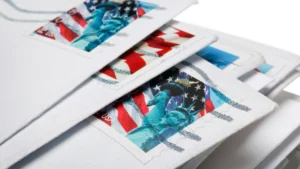Starting a direct mail campaign for your business? Many companies use direct mail to reach customers in a personal and powerful way. With the right strategy, direct mail can help you stand out, drive sales, and get real results.
Learn how direct mail works, how to choose the best type for your goals, how to plan based on your industry, and how to track your return on investment (ROI).
Let’s get started!

How Do Direct Mail Campaigns Work?
Direct mail campaign marketing means sending printed materials directly to people through the mail as part of a planned marketing effort. These materials can include postcards, flyers, brochures, letters, catalogs, and even custom packages. The goal is to grab attention, deliver a clear message, and drive a specific action, such as visiting a website, scanning a QR code, or visiting a local location.
For businesses with multiple locations, a dedicated marketing team, and a need for printed materials, direct mail offers several unique advantages:
- It’s targeted. You can send materials to specific ZIP codes, customer types, or business sectors.
- It’s personal. With variable data printing, you can personalize each piece with the recipient’s name, location, or even their past purchase behavior.
- It’s tangible. Unlike digital ads that are easy to scroll past, direct mail is something people can hold, pin to a board, or hand to a colleague.
When done right, direct mail works well with your other marketing channels, like email, social media, and digital ads. For example, you might send a postcard that promotes a campaign landing page, which then leads to email follow-ups.
Because your business likely already manages print needs for business cards, signage, and trade show booths, direct mail fits naturally into your existing workflow. Plus, it gives you full control over the design, print quality, and messaging – all key when you’re representing a brand across many locations.
Direct mail is especially useful for:
- Launching local promotions or grand openings
- Promoting seasonal or limited-time offers
- Reaching hard-to-target B2B decision-makers
- Supporting enrollment campaigns at universities or recruitment for city programs
- Keeping franchise marketing consistent while still local
Direct mail campaign marketing is a hands-on, targeted way to reach the right people with the right message, especially when brand consistency and print quality matter.
Choosing the Right Type of Direct Mail Campaign
When you’re planning a direct mail campaign, one of the first things you need to figure out is what kind of mail to send. The type you choose will depend on your message, your goal, and who you’re trying to reach. Let’s break it down in simple terms so you can pick the best option for your business.
1. Postcards
Postcards are simple and cost-effective. They’re great for quick messages like promoting a sale, announcing a grand opening, or reminding customers about an appointment. Since there’s no envelope, your message is seen right away.
When to use:
- You want to catch attention fast
- You’re running a time-sensitive offer
- You want to save on postage and printing
2. Letters and Envelopes
A letter in an envelope feels more personal and private. It’s great when you want to explain something in more detail or send a message that feels important, like a university enrollment package or a city notice.
When to use:
- You’re targeting business professionals or donors
- You need space for more detailed info
- You want to add a formal touch
3. Brochures and Flyers
Brochures and flyers give you more room to tell your story. You can add images, descriptions, and even maps or schedules. These work well for trade shows, new services, or educational campaigns.
When to use:
- You want to explain your products or services
- You’re promoting an event or launch
- You need something customers can keep or share
4. Catalogs
If you have lots of products, a catalog is a strong choice. It gives your customers something they can flip through. You can include product photos, prices, and even customer reviews.
When to use:
- You sell multiple items
- You want customers to browse and buy later
- You have seasonal or promotional collections
5. Dimensional Mailers
These are more creative pieces like boxes, folded packages, or pop-up mailers. They’re more expensive, but they grab attention and feel like a gift. That makes them perfect for high-value customers or special campaigns.
When to use:
- You’re targeting decision-makers
- You want to stand out from regular mail
- You’re launching something big or exclusive
Look at what your audience needs to see and how they’ll use it. Do they just need a reminder? Go with a postcard. Are they making a big decision? A letter or brochure might be better. If you match the type of mail to your message, you’ll get better results every time.
Industry-Based Direct Mail Strategies
The strategy you use should match your industry, your goals, and the kind of people you’re trying to reach. If your business has multiple locations or serves a wide audience, like a franchise, a university, or a city department, this part is especially important.
Let’s go over a few simple ideas to help you choose the right direct mail approach for your industry.
1. For Universities and Colleges
If you’re in higher education, you know how important it is to reach potential students and keep current ones informed.
Direct mail ideas:
- Personalized acceptance letters with a welcome brochure
- Postcards about open houses or campus tours
- Flyers for financial aid reminders or registration deadlines
Mail feels more personal than email, and students (and parents) are more likely to remember it.
2. For Cities and Local Governments
You need to keep residents informed and involved. Direct mail is great for building trust and reaching people of all ages, even those who aren’t online often.
Direct mail ideas:
- Community newsletters
- Announcements for public meetings, voting, or events
- Emergency preparedness guides or safety tips
People trust official mail from their city, and it’s a clear way to get important information into their hands.
3. For Franchise Operations
If you’re running or supporting franchises, you need to keep branding consistent while also supporting local marketing.
Direct mail ideas:
- Grand opening postcards for new locations
- Coupons tailored to the local area
- Holiday or seasonal campaigns
It helps each location feel local while keeping your brand strong across the board.
4. For Corporations and B2B Brands
If your audience is other businesses, you need to look professional and stand out. Many B2B buyers get tons of digital noise, but direct mail gives them something different.
Direct mail ideas:
- Product launch kits with samples or brochures
- Personalized letters to key decision-makers
- Invitations to webinars or trade shows
Mail is harder to ignore and often makes a stronger impression than another email in the inbox.
Ways to Track the ROI of Direct Mail
If you’re spending money on direct mail, you want to know it’s working. That’s where ROI comes in. ROI tells you how much money you make compared to what you spend on a campaign.
The good news? Direct mail is one of the best ways to get strong results.
In fact:
- Postalytics reports that direct mail brings in an average ROI of 112%, which beats SMS (102%), email (93%), and paid search (88%).1
- A 2024 survey by Lob found that 84% of marketers said direct mail gives them the best return out of all the marketing channels they use. 2
Now, here’s how you can track your direct mail ROI in simple ways.
1. Use Unique Promo Codes or Coupons
Add a code to your mail piece that customers can use when they buy something, online or in person. If people use that code, you know they got it from the mail.
Example: “Use code MAIL20 for 20% off”
When someone uses it, you can track where they came from.
2. Create a Special Landing Page or URL
Send people to a web page made just for your campaign. That way, you can count how many people visit and take action.
Example: YourMailCampaign.com/FreeSample
You’ll know everyone who visits came from your direct mail.
3. Add a QR Code
A QR code makes it easy for people to scan your mail with their phone and go straight to your website or offer. You can track every scan.
Tip: Use a QR code that’s tied to your campaign so you can see exactly how many people used it.
4. Use Call Tracking Numbers
If your campaign includes a phone number, make it a unique one. That way, when someone calls, you’ll know they saw your mail piece.
Bonus: Some call tracking services even record the calls so you can learn what works.
5. Match Back to Sales Data
If you sent mail to a list of people or businesses, check to see if they made a purchase after getting it. This is called a “matchback.”
How it helps: Even if someone didn’t use a coupon or QR code, you can still tell if your campaign influenced a sale.
6. Use a CRM or Direct Mail Platform
If you have a CRM (like Salesforce or HubSpot) or use a mail automation tool, you can track responses and conversions automatically. These tools can show who opened, scanned, or responded to your mail.
Tracking your ROI doesn’t have to be complicated. Just choose one or two simple methods that work for your business. When you know what’s working, you can do more of it and stop wasting funds on what’s not.
Ready to turn your next campaign into real results? Advertise with mail and do it with The Printery. Whether it’s postcards, letters, brochures, or full campaign support, we work with your marketing team to create materials that reach your audience on time and on budget.

Sources:
- Gain knowledge and understanding of the direct mail industry and important trends with our collection of 48 key direct mail statistics you should know DIRECT MAIL STATISTICS FOR MARKETERS IN 2024. (n.d.). https://www.postalytics.com/wp-content/uploads/2024/02/POSTALYTICS_Direct-Mail-Statistics-for-Marketers-in-2024_PDF.pdf
- 2024 The State of Direct Mail Marketing [Review of 2024 The State of Direct Mail Marketing]. Go.lob.com; Lob and CompereMedia. https://go.lob.com/rs/900-QJF-050/images/2024-Lob-State-of-Direct-Mail-Marketing.pdf



